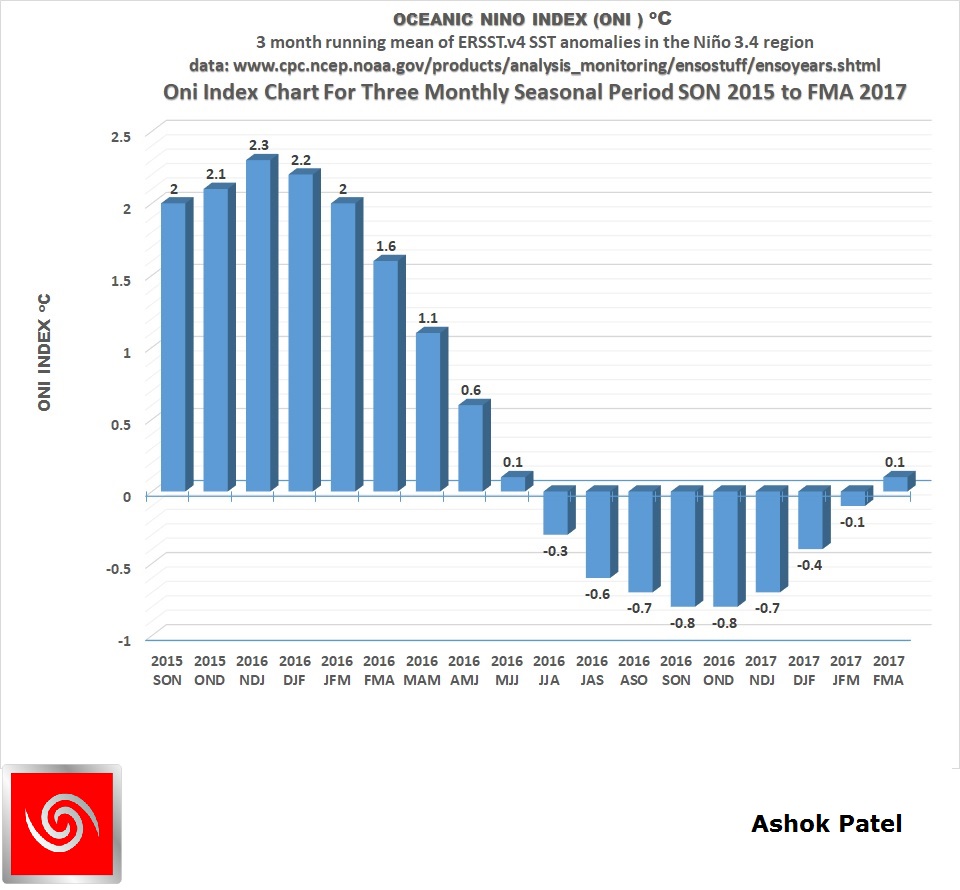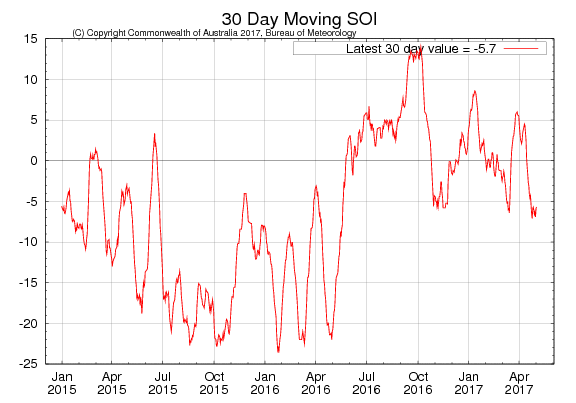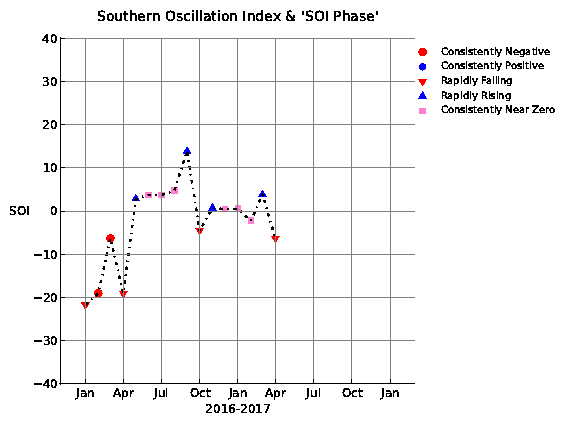ENSO Status on 5th May 2017
The ONI is based on SST departures from average in the Niño 3.4 region, and is a principal measure for monitoring, assessing, and predicting ENSO. Defined as the three-month running-mean SST departures in the Niño 3.4 region. Departures are based on a set of improved homogeneous historical SST analyses (Extended Reconstructed SST – ERSST.v4). The SST reconstruction methodology is described in Huang et al., 2015, J. Climate, vol. 28, 911-930.
CPC uses current Climatology based on 1986-2015 which has been changed late last year from base years 1981-2010. Explanation about Climatology base years change is given here.
NOAA Operational Definitions for El Niño and La Niña, El Niño: characterized by a positive ONI greater than or equal to +0.5ºC. La Niña: characterized by a negative ONI less than or equal to -0.5ºC. By historical standards, to be classified as a full-fledged El Niño or La Niña episode, these thresholds must be exceeded for a period of at least 5 consecutive overlapping 3-month seasons.
CPC considers El Niño or La Niña conditions to occur when the monthly Niño3.4 OISST departures meet or exceed +/- 0.5ºC along with consistent atmospheric features. These anomalies must also be forecast to persist for 3 consecutive months.
Enso neutral conditions have prevailed after the demise of short lived La Nina having last 3-monthly season as NDJ 2017.
ONI Index for DJF 2017 was -0.4ºC, JFM 2017 is -0.2ºC FMA 2017 is +0.1ºC and hence the Nino 3.4 Region of Pacific Ocean continues to remain in ENSO Neutral zone.
Latest Oceanic Nino Index (ONI) Graph Showing Enso Neutral Event For Last Three 3- Monthly Seasons Ending April 2017
The Table below shows the monthly SST of Nino3.4 Region and the Climate adjusted normal SST and SST anomaly for last two years. Climate Base 1986-2015.
Period Nino3.4 ClimAdjust YR MON Temp.ºC Temp.ºC ANOM ºC 2015 4 28.59 27.86 0.73 2015 5 28.83 27.98 0.85 2015 6 28.70 27.76 0.94 2015 7 28.50 27.37 1.13 2015 8 28.47 27.02 1.45 2015 9 28.62 26.94 1.68 2015 10 28.86 26.91 1.95 2015 11 29.14 26.88 2.25 2015 12 29.04 26.80 2.24 2016 1 28.95 26.61 2.33 2016 2 28.89 26.80 2.09 2016 3 28.86 27.32 1.54 2016 4 28.96 27.86 1.10 2016 5 28.59 27.98 0.60 2016 6 27.81 27.76 0.05 2016 7 26.98 27.37 -0.39 2016 8 26.39 27.02 -0.63 2016 9 26.20 26.94 -0.74 2016 10 26.04 26.91 -0.87 2016 11 25.96 26.88 -0.93 2016 12 26.08 26.80 -0.72 2017 1 26.24 26.61 -0.37 2017 2 26.63 26.80 -0.17 2017 3 27.49 27.32 0.17 2017 4 28.29 27.86 0.43
CPC considers El Niño or La Niña conditions to occur when the monthly Niño3.4 OISST departures meet or exceed +/- 0.5°C along with consistent atmospheric features. These anomalies must also be forecast to persist for 3 consecutive months.
Southern Oscillation Index
As per BOM, Australia:
The 30-day Southern Oscillation Index (SOI) to 24 April was −6.6 (90-day value −0.3). SOI values have generally been within the neutral range since mid-October.
The latest 30-day Southern Oscillation Index (SOI) on 3rd May 2017 is -5.7 within the neutral ENSO range.
Sustained positive values of the SOI above +7 typically indicate La Niña while sustained negative values below −7 typically indicate El Niño. Values between about +7 and −7 generally indicate neutral conditions.
SOI Monthly graph up to April 2017 as per The Long Paddock – Queensland Government.
SOI was -6.31 at the end of April 2017 and -6.35 on 5th May 2017 as per The Long Paddock – Queensland Government.
Summary by: Climate Prediction Center / NCEP Dated 1st May 2017
ENSO Alert System Status: Not Active
ENSO-neutral conditions are present.* Equatorial sea surface temperatures (SSTs) are near-average across the central Pacific. They are above-average in the eastern Pacific Ocean. ENSO-neutral conditions are favored to continue through at least the Northern Hemisphere spring 2017, with increasing chances for El Niño development by late summer and fall.*
* Note: These statements are updated once a month (2nd Thursday of each month) in association with the ENSO Diagnostics Discussion, which can be found by clicking here
As per BOM -Australia 28th March 2017
ENSO neutral, but tropical Pacific waters continue to warm – El Niño WATCH Remains:
The El Niño–Southern Oscillation (ENSO) remains neutral. However, the Bureau’s ENSO Outlook status is at El Niño WATCH, indicating around a 50% chance of El Niño developing in 2017.
Ashok Patel’s Final Note: Full Fledged El Nino Not Possible During The Indian Southwest Monsoon 2017 Using NOAA Criteria.
The current SST of Nino 3.4 region is below +0.5°C at +0.43°C and also the last ONI Index available is FMA 2017 at just +0.1°C which is yet in the Enso Neutral zone. The SST for May is not expected to reach +0.9°C and hence the ONI Index for MAM 2017 will be < 0.5°C. Even if MAM 2017 reaches +0.5, and only if the NINO 3.4 region heats up continuously for the next Four 3-monthly seasons namely AMJ 2017, MJJ 2017, JJA 2017 & JAS 2017 and if all the ONI indexes manages to remain equal to or above 0.5°C only then it will qualify for a Full fledged El Nino as per NOAA criteria. However, the Southwest Monsoon 2017 would have already ended by that time.
અશોક પટેલ ની નોંધ :
ઓસ્ટ્રેલિયા ની BOM સંસ્થા મુજબ 2017 માં એલ નિનો થવા ની 50% શક્યતા ના એંધાણ આપવામાં આવ્યા હોવા છતાં મારુ માનવું છે કે આગામી ચોમાસા દરમિયાન વિધિવત એલ નિનો (NOAA, U.S. ના માપ દંડ મુજબ ) શક્ય નથી. વિધિવત એલ નિનો જો ડિક્લેર થાય તો પણ ભારત નું દક્ષિણ પશ્ચિમ ચોમાસુ ત્યારે પૂરું થઇ ગયું હશે.



IOD negative rahse k positive??Final kyare khabar pdse IOD vise??
IOD haal positive chhe.
Sir how can I share image with you? Is it possible?
You can send a link of the image
Thank you sir
Sir when will premonsoon activities start in Goa? Or is it already started? Can we expect premonsoon activities in may end for Gujarat I mean in last week of May?
Premonsoon starts over South India and Andaman & Nicobar.
Then Nortwards.
Sir IOD vise janavo
Aavey chhe toonk time ma, Taiyar thaay chhe…IOD no ghanvo
Very good news for Gujrat Farmer’s
Tnx sir
Sir aa currently je long time thi anti cyclone AB ma che te koi system banva de aevu lagtu nathi. Aetle monsoon pela je AB active revu joi ke koi sari system bani ne Gujarat ma varsad lave teva sanjog next 10 days sudhi to nathi dekhata. Local clouds may do some relief hopefully.
Very good news , sir ji
Thank you very much
Good news for india…. Thanks for information sir ji
Dear sir,
This year Arab sagar kai jor batavse ke last year ni jem thando rahese.?
It depends upon IOD ( Indian Ocean Dipole )
Sir
Monsoon na ek paribal upar rahat na news appya tame. Have IOD vishe shu kahevu chhe aa varsh mate?
thanks for update sir.
Thanks for final note. Good news